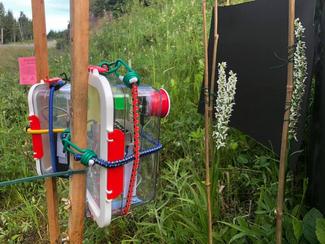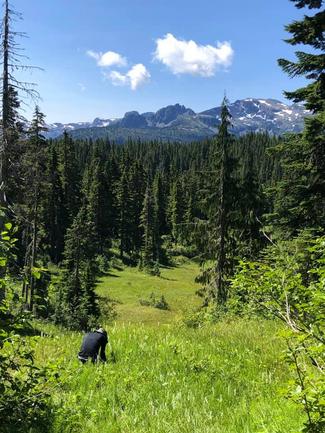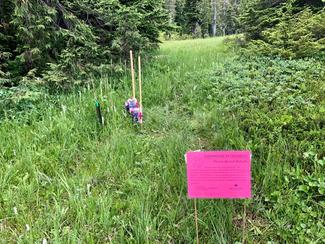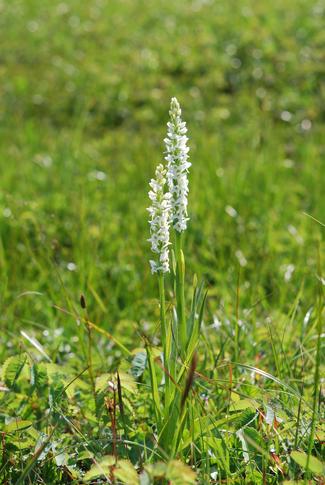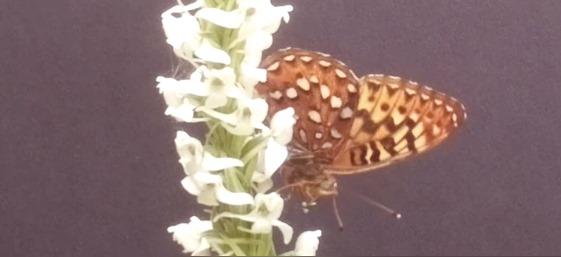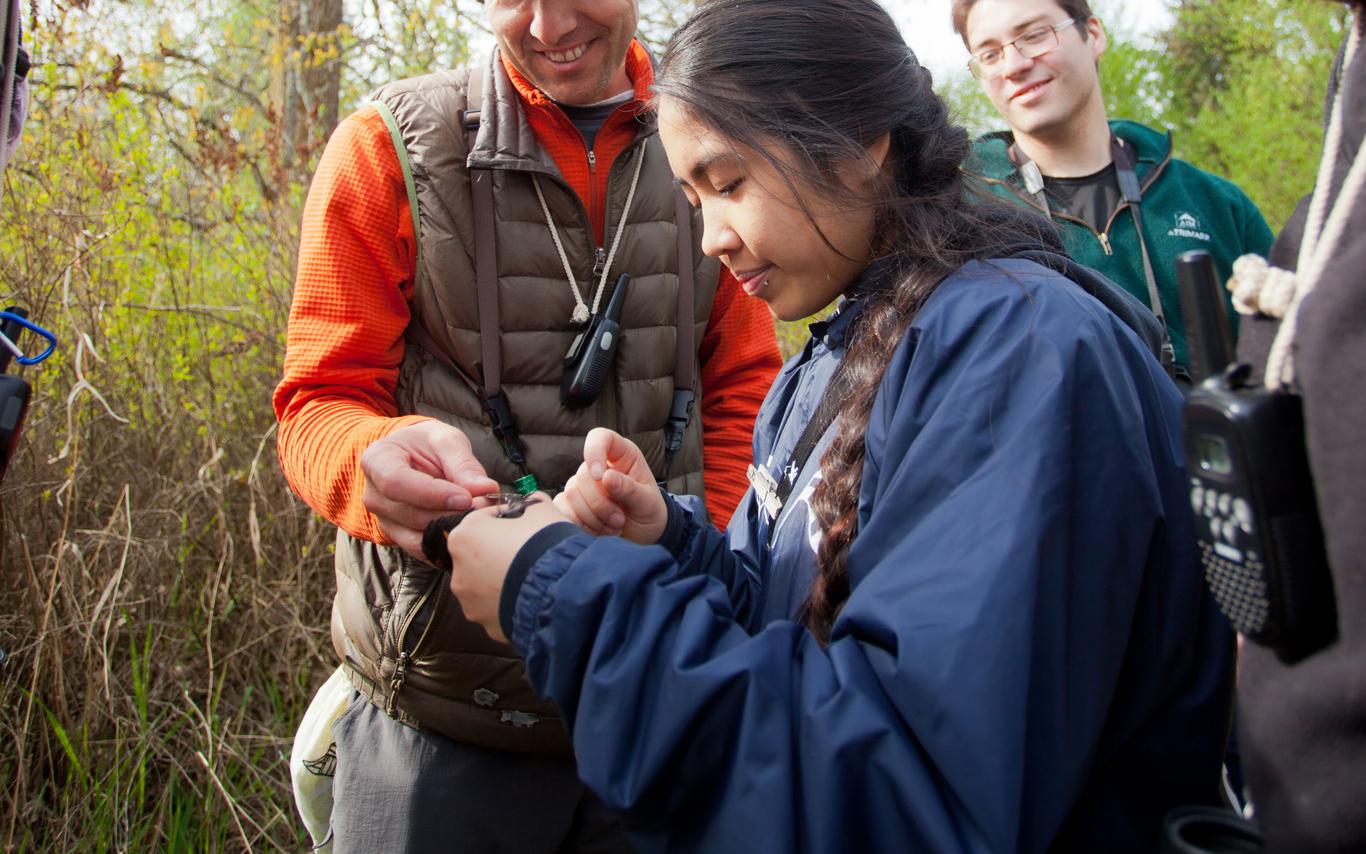Thank-you to everyone who participated in Research Month!
Check out the Abstracts from the Faculty Symposium held on April 16, including:
- Dr. Shannon Dames: Establishment of First Integrated Psychedelic Medicine Assisted Therapies (PMAT) Program in BC's Healthcare System
- Dr. Bob Esliger: Providing Equitable and Accessible Educational Programs During a Pandemic: Leadership Structures and Instructional Practice
- Dr. Tehmina Khwaja and Melissa Lyon: Building an Equity, Diversity and Inclusion Community of Practice
- Dr. Georgina Martin: The newly established tri-agency national Reference Group for the Appropriate Review of Indigenous Research
- Robin Davies: Conversations - In the Arts & Humanities
- Dr. Don Alexander: Ingredients for University Leadership in Fostering Climate Resilience: Using Royal Roads as a Case Study
- Stacie Chappell: Classroom As Organization
- Danielle Alphonse: Language of the Land
- Dr. Gillian Anderson and Dr. Sylvie Lafreniere: “Who Cares?”: Women’s Employment Trends on Vancouver Island-Coast During the First Wave of COVID-19
- Dr. Leigh Blaney: Pivot the project: How the ‘Indomitable Spirit in Nursing’ flipped to comply with Covid research guidelines
- Dr. Jamie Gorrell (Video): Genomic Diversity and Relatedness in Captive and Wild Vancouver Island Marmots
- Dr. Pam Shaw: K’ómoks First Nation: Community Pulse 2020
- Dr. Patrick Brouder: Changing TAC? The evolution of Tourism, Arts, & Culture (TAC) and what it means for BC post-COVID-19
- Dr. Sylvie Lafreniere (Video): The Mount Arrowsmith Biosphere Region Community Pulse report
- Dr. Tim Green: Future-proofing the shellfish industry in British Columbia against climate change
- Dr. Russell Campbell: Real-time Level-Surface Volumetric Simulation Reductions
'Research in Action' Posters!
What Matters 2.0: Voices of Chinese Older Adults
Are Chinese Older Adults suffering in silence? Many Chinese older adults immigrate to Canada to be with their families, leaving behind their established social network from their country of origin. Earlier work has shown that the age of immigration, level of education and fluency (or lack of) in either of Canada’s official languages contribute to increased reliance on public funds, higher rates of social isolation and increased mortality (Citizenship and Immigration Canada, 2005; Employment and Social Development Canada, 2018). As healthcare providers, we have a vested interest to promote physical, mental and social health outcomes for immigrants living in our communities. The complexity of acculturation in a new country necessitated Chinese older adults to adapt to different cultural contexts while trying to live by their traditional values. What is it like for Chinese older adults living in British Columbia and Alberta? Here is what we have learned from their stories and perspectives. Check out the poster below.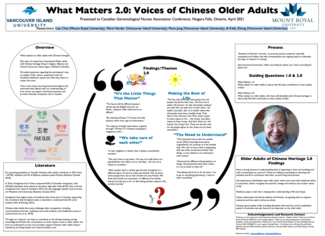
Providing Equitable and Accessible Educational Programs During a Pandemic: Leadership Structures and Instructional Practice
The coronavirus (COVID-19) pandemic has amplified differences among learners and presented many unique challenges to the leadership of British Columbia's 60 K-12 public school districts. The urgency to respond to the pandemic has led to school closures, complex reopening procedures, and the necessity for new safety protocols, all of which have taken priority leaving little time to contemplate equitable and accessible instructional delivery for students.The health issues brought about by the COVID-19 pandemic have necessarily derailed change efforts in school districts; however, it does provide the opportunity to gain a new perspective regarding school district leadership structures and frameworks that best provide for the needs of all learners.This research project is a partnership between Vancouver Island University and the BC Council of Administrators of Inclusive Supports in Education (BCCAISE) and the goal is to investigate what has worked, and what didn’t, in supporting all students’ access to equitable education in BC during this pandemic. Never before has the relationship between a pandemic crisis and the delivery of educational programs been so closely connected to the organization and leadership of a school district. Outcomes will impact leadership competencies of district leaders as well as school district structures and frameworks. Check out the poster below.
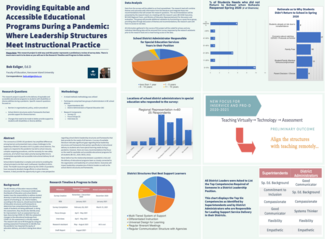
Videos of Research in Action
See Research videos, including:
Sylvie LaFreniere and the Mt. Arrowsmith Vital Signs Project: A collaboration between the Parksville-Qualicum Community Foundation (PQCF) and the Mount Arrowsmith Biosphere Region Research Institute (MABRRI) to produce a Vital Signs report. This an interesting region to study because its boundaries, based on five watersheds, are natural rather than political or social. At the end of this project, students will have converted the MABR’s natural boundaries into Statistics Canada’s geographical units; identified important indicators to include in the report based on available data; conducted interviews with community members; designed the Vital Signs final report; documented the work in order to facilitate the preparation of future reports. This Vital Signs report will provide a snapshot of the municipalities within the MABR and provide valuable information regarding the population and how they live within this extraordinary region.
Jamie Gorrell and the Vancouver Island Marmots Project: The Vancouver Island marmot (Marmotavancouverensis) is one of the most endangered mammals in Canada and, similar to other species, the strategy currently employed to save these animals involves captive breeding and reintroduction. While this strategy has shown short-term success by increasing the number of marmots in the wild, we do not know how these reintroduced marmots are contributing to the ecological and evolutionary potential(i.e.,fitnesseffects)forlong-termrecoveryofthespecies.My long-term research goal is to understand the dynamic interactions between ecological effects and evolutionary potential and how we can influence these processes to rescue endangered populations. Over the next five years, my students and I will determine how captivity and reintroduction has changed genetic diversity and individual fitness of Vancouver Island marmots, and what implications these changes have on the long-term survival of the species. This RIF application is intended to accelerate this project by facilitating research time and funding DNA sequencing.
Shannon Dames and the Psychedelic Medicine Assisted Therapies Project: VIU has partnered with Island Health, Cedars Addiction Treatment Centre, Numinus, Indigenous Elders,and researchers from UBC and the University of Victoriato explore the use Ketamine Assisted Psychotherapy (KAP) in combination with aresiliency program to treat PTSD and depression in healthcare providers. Ketamine is touted as the most significant advance in the treatment of depression in over 50 years. Using Patient Oriented (POR) and Reconciliation-focused methodologies, the objectives of the project are 1) to convene key stakeholders to research the regulatory and methodological framework for using Psychedelic Medicine Assisted Therapies (PMAT) within in the public health care system on Vancouver Island, and 2)to design and pilot test the use of KAP concurrent with the Roots to Thrive resilience curriculum in a small population of patient-providers.
Pam Shaw and the Komoks First Nation Community Pulse Project: A collaboration between the K’ómoks First Nation and VIU to: [1] Create a Vital Signs style community report, referred to as the Community Pulse, that reflects demographic, economic, social, and environmental indicators; [2] Generate a pass-over document that may be useful in coming years for updating the Community Pulse document; and [3] Host a short training session with K’ómoks First Nation staff on how to update the document on an annual basis. K’ómoks First Nation will be providing the research team with data that they have previously collected with regards to their community’s current state. The data will be compiled into a final report that can ultimately be updated on an annual basis by K’ómoks First Nation staff and Council. The report will be shared with the K’ómoks First Nation members and surrounding communities, showcasing the current state of the community, the work they are doing, and what they would like to work towards in the future.
Invitation by Video by Antje Bitterberg, Rosemary Antony and Ann Peterburgh to join the VIU ECEC blog Re-searching Early Childhood Pedagogies. A new space where students, educators, and instructors can come together to think, listen, and wonder across VIU communities. A lively blog culture has emerged with contributions that invite and experiment with complexity and move beyond a submission posted, praised, and forgotten.
Dr. Russell Campbell's You-Tube Video on Real-Time Level-Surface Volumetric Simulation Reduction. "Our approach to real-time volumetric simulations visualizes volumetric effects using level surfaces. Other 3D geometry can thus interact and the volumetric effects approach a more realistic immersion for the player. We are then also able to manage the simulations for controlled bounds on computational resources. This leaves us with a somewhat banded effect on the simulation, but since we are now rendering less, we will use less computation. Various methods to fill the discontinuity will also be discussed."
Research in Action Photos!
From Stefan Iwasawa from the Centre for Coastal Health: Over the past 9 years I’ve been involved in water sampling recreational beaches and irrigation canals in the Fraser Valley in order to determine the bacterial load. Due to covid travel restrictions we are currently looking at sampling recreational beaches and lakes in the Nanaimo area. The other project that I’m working on involves tick sampling on Vancouver Island. One project is looking at ticks and their distribution due to climate change while the other is looking at the prevalence of Lyme disease in ticks across Canada.
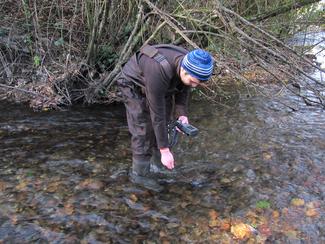
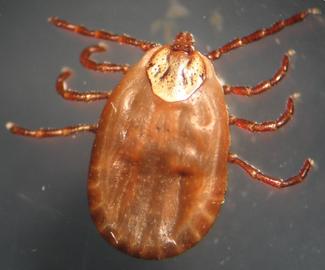
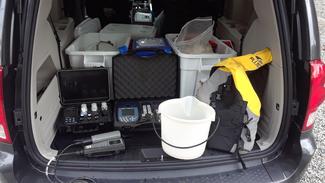
From Jasmine Janes, Biology Professor: During the summer of 2020, we used continuous video monitoring to identify the pollinators and floral visitors of Platanthera dilatata (white bog orchid) at Mt. Washington. We identified bees, butterflies and moths performing pollination throughout the day and night.
